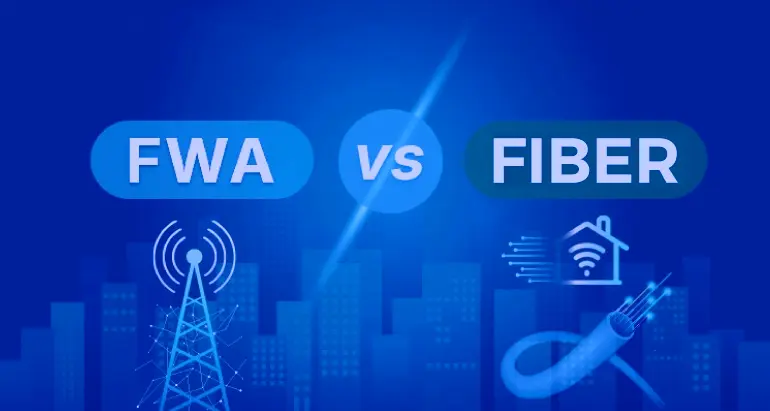Fibre-to-the-home (FTTH) provides South Africans with stable and affordable uncapped Internet, the technology is not always feasible to deploy, opening the door to competing wireless technologies.
While fibre-to-the-home (FTTH) provides South Africans with stable and affordable uncapped Internet, the technology is not always feasible to deploy, opening the door to competing wireless technologies.
These competing technologies, called fixed wireless access (FWA), rely on radio networks for the last-mile connection instead of a wired connection, such as a fibre cable.
Therefore, FWA is ideal for users in rural areas without installed fibre or those looking for temporary access.
Regarding fibre rollouts, of the 3.2 million addressable homes in the upper-income South African market, 3.1 million have access to at least one fibre network operator (FNO).
This is according to BMIT’s South African Broadband Report for 2024, which said 48.7% homes have been connected.
However, BMIT’s research shows that these figures rapidly drop for the middle and lower income brackets.
Only 2.2 million of the 4.3 million addressable middle-income homes have been passed, and 16.5% have been connected.
According to BMIT, there are 5 million addressable lower-income homes. However, only 100,000 have been passed, and 0.4% are connected to a network.
This means South Africans who would like to use FTTH services may be unable to access them because of this constraint, leaving them looking for alternatives such as LTE and 5G.
BMIT’s 2023 version of the report found that fixed-LTE was by far the leading broadband medium in South Africa, which can primarily be attributed to its broad population coverage.
Mobile operators like MTN and Vodacom offer this service and spend billions on expanding and maintaining networks that cover roughly 99% of the country.
Newer market entrant Rain has built its own 4G network to offer wireless broadband and has since begun offering full mobile services.
While fixed-5G and LTE access may be readily available and easy to set up, often as simple as slotting a SIM card into a router, they are more vulnerable to external factors that may degrade performance.
Benefits and challenges
Cellular network operators offering fixed wireless access face several challenges as they connect end users to their core networks via wireless antennas deployed at base stations.
One of these challenges is load-shedding, as base stations require an electricity supply. While network operators have invested in backup energy sources, these are often subject to theft and vandalism.
These networks are also vulnerable to adverse weather conditions that can interfere with the wireless signals from users.
Fibre, on the other hand, is not vulnerable to this type of external interference as the cables are laid underground and are not worth stealing, as they do not contain metals.
Although fibre networks also require relay facilities similar to cellular networks’ base stations, they are far fewer and therefore less costly to physically secure and provide backup power to.
Fibre also allows for much higher speeds as the bandwidth available in a fibre optic cable dwarfs that of the radio frequency spectrum available to wireless network operators.
On an FWA network, data only travels via fibre optic cables between the base station and the data centre, meaning the last-mile wireless link may slow down a user’s experience.
However, as companies invest more in advanced wireless technologies like 5G, these will become more readily available to customers and offer faster FWA services.
The limited bandwidth available over wireless networks also means these types of services are likely to have stricter fair usage policies than fibre networks.
This means most uncapped FWA services will begin throttling Internet usage once users have passed a specific threshold.
As for the price, entry-level uncapped LTE packages are generally more affordable than fibre and fixed-5G, but offer far lower speeds.
Fixed-5G packages, on the other hand, offer significantly higher speeds than LTE and are often more affordable than fibre packages, given these speeds. However, they generally have FUPs.
Rain is an exception, as its packages do not include fair usage restrictions. The trade-off is lower maximum speeds than other network operators.
It is also worth noting that while LTE networks cover roughly 99% of the country, 5G network access is not as widespread, sitting at just over 51% at the end of March 2025.
| Service provider | FNO/mobile network | Download/upload (Mbps) | FUP limit | Price |
|---|---|---|---|---|
| Fixed-LTE | ||||
| Axxess | MTN | Up to 30Mbps | 50GB | R349 |
| Axxess | Vodacom | Up to 30Mbps | 50GB | R399 |
| Mweb | MTN | Up to 15Mbps | 350GB | R419 |
| Mweb | Telkom | Up to 20Mbps | 500GB | R549 |
| Fixed-5G | ||||
| Afrihost | MTN | Up to 50Mbps | 150GB | R399 |
| Axxess | MTN | Up to 500Mbps | 300GB | R449 |
| Axxess | Vodacom | Up to 500Mbps | 250GB | R495 |
| Rain | Rain | Up to 30Mbps | – | R649 |
| Fibre | ||||
| Mweb | Openserve | 25/25 | – | R399 |
| Axxess | Vumatel | 100/50 | – | R799 |
| Webafrica | Frogfoot | 240/120 | – | R875 |
| Afrihost | Metrofibre | 500/500 | – | R1,267 |

